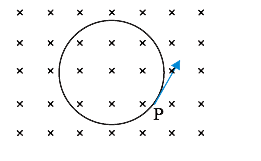A α -parhticle moves in a circular path of radius 0.83cm in the presence of a magnetic field of 0.25Wb/m2. The de-Broglie wavelength assocaiated with the particle will be
1Ã…
0.1Ã…
10Ã…
0.01Ã…
The correct Answer is:D
To find the de-Broglie wavelength associated with an alpha particle moving in a circular path in a magnetic field, we can follow these steps:
Step 1: Understand the relationship between forces
In a magnetic field, the centripetal force acting on the alpha particle is provided by the magnetic force. Therefore, we can equate the centripetal force to the magnetic force:
Fcentripetal=Fmagnetic
This can be expressed as:
mv2r=qvB
Where:
- m = mass of the alpha particle
- v = velocity of the alpha particle
- r = radius of the circular path
- q = charge of the alpha particle
- B = magnetic field strength
Step 2: Solve for momentum
Rearranging the equation gives:
mv=qvBr
Dividing both sides by v (assuming v≠0):
m=qBr
The momentum p of the particle is given by:
p=mv=qBrv
Step 3: Use the de-Broglie wavelength formula
The de-Broglie wavelength λ is given by:
λ=hp
Substituting the expression for momentum:
λ=hqBr
Step 4: Substitute the known values
Now, we will substitute the known values into the equation. The constants are:
- Planck's constant h=6.63×10−34Js
- Charge of an alpha particle q=2×1.6×10−19C
- Magnetic field B=0.25Wb/m2
- Radius r=0.83cm=0.0083m
Substituting these values into the equation for wavelength:
λ=6.63×10−34(2×1.6×10−19)×0.25×0.0083
Step 5: Calculate the wavelength
Calculating the denominator:
q=2×1.6×10−19=3.2×10−19C
Now, substituting into the equation:
λ=6.63×10−34(3.2×10−19)×0.25×0.0083
Calculating the denominator:
3.2×10−19×0.25×0.0083=6.64×10−22
Now, substituting this back into the equation for λ:
λ=6.63×10−346.64×10−22≈9.96×10−13m
Step 6: Convert to Angstroms
To convert meters to Angstroms (1 Angstrom = 10−10m):
λ≈9.96×10−13m=9.96×101Å≈0.01Å
Final Answer
Thus, the de-Broglie wavelength associated with the alpha particle is approximately:
λ≈0.01Å
In a magnetic field, the centripetal force acting on the alpha particle is provided by the magnetic force. Therefore, we can equate the centripetal force to the magnetic force:
- m = mass of the alpha particle
- v = velocity of the alpha particle
- r = radius of the circular path
- q = charge of the alpha particle
- B = magnetic field strength
Rearranging the equation gives:
The de-Broglie wavelength λ is given by:
Now, we will substitute the known values into the equation. The constants are:
- Charge of an alpha particle q=2×1.6×10−19C
- Magnetic field B=0.25Wb/m2
- Radius r=0.83cm=0.0083m
Calculating the denominator:
To convert meters to Angstroms (1 Angstrom = 10−10m):
Thus, the de-Broglie wavelength associated with the alpha particle is approximately:
Topper's Solved these Questions
- DUAL NATURE OF RADIATION AND MATTER BOOK - NCERT FINGERTPS ENGLISHCHAPTER - DUAL NATURE OF RADIATION AND MATTER EXERCISE - DAVISSON AND GERMER EXPERIMENT
3 Videos
- DUAL NATURE OF RADIATION AND MATTER BOOK - NCERT FINGERTPS ENGLISHCHAPTER - DUAL NATURE OF RADIATION AND MATTER EXERCISE - HIGHER ORDER THINKING SKILLS
8 Videos
- DUAL NATURE OF RADIATION AND MATTER BOOK - NCERT FINGERTPS ENGLISHCHAPTER - DUAL NATURE OF RADIATION AND MATTER EXERCISE - PARTICLE NATURE OF LIGHT : THE PHOTON
19 Videos
- CURRENT ELECTRICITYBOOK - NCERT FINGERTPS ENGLISHCHAPTER - CURRENT ELECTRICITYEXERCISE - Assertion And Reason
15 Videos
- ELECTRIC CHARGES AND FIELDSBOOK - NCERT FINGERTPS ENGLISHCHAPTER - ELECTRIC CHARGES AND FIELDSEXERCISE - Assertion And Reason
15 Videos
Similar Questions
Knowledge Check
A particle travels in a circular path of radius 0.2 m with a constant kinetic energy of 4J . What is the net force on the particle?
A4NB16NC20ND40N
A particle having the same charge as of electron moves in a circular path of radius 0.5 cm under the influence of a magnetic field of 0.5 T. If an electric field of 100V/m makes it to move in a straight path, then the mass of the particle is ( Given charge of electron =1.6×10−19C)
View SolutionThe ratio of the de Broglie wavelength of a proton and alpha particles will be 1:2 if their
View SolutionThe ratio of the de Broglie wavelength of a proton and alpha particles will be 1:2 if their
View SolutionAn electron is moving on a circular path of radius r with speed v in a transverse magnetic field B. e/m for it will be
View SolutionA particle is moving on a circular path of radius 1 m with 2 m/s. If speed starts increasing at a rate of 2m/s2, then acceleration of particle is
View SolutionThe radius of and α-particle moving in a circle in a constant magnetic field is half of the radius of and electron moving in circular path in the same field. The de Broglie wavelength of α-particle is n times that of the electron. Find n (an integer).
View SolutionA particle having a charge of 10.0μC and mass 1μg moves in a circle of radius 10 cm under the influence of a magnetic field of induction 0.1T. When the particle is at a point P, a uniform electric field is switched on so that the particle starts moving along the tangent with a uniform velocity. The electric field is

View Solution
